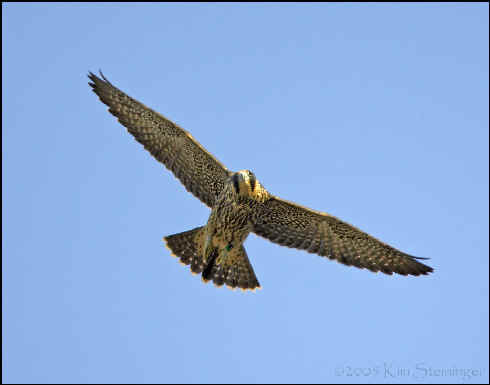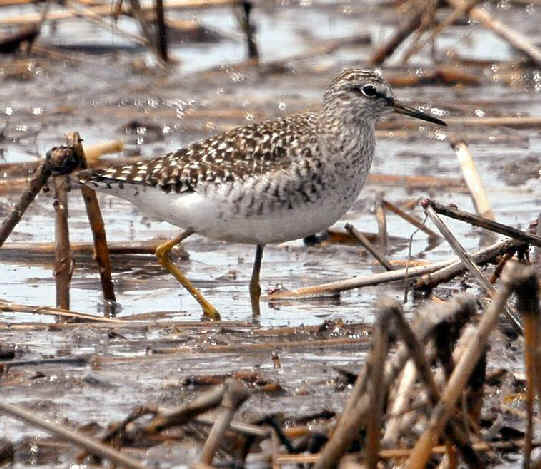The next edition of our Natureline will be a special
one, referring to the 100 MOST ENDANGERED SPECIES on
Earth - a list with not just BIRDS, but also containing
OTHER CREATURES and PLANTS.
But here, now, only BIRDS as we refer to the MIGRATION
that has been well underway in eastern North America, plus a
few BIRDS lately in Iceland.
The rarest in eastern North America recently
has been a WOOD SANDPIPER in the smallest US state of
Rhode Island, on Jamestown Island in the Narragansett Bay.
Good luck had it that it was found on October 13, and it
continued to be seen beyond that.
The Rhode Island bird was the 5th occurrence of a WOOD
SANDPIPER in the lower 48 states of the US, and the 1st
record for the New England states.
In Iceland, this past week, there were extralimital SANDPIPERS from
both North America and mainland Eurasia. In fact, they were
seen together, at the same location.
A TEMMINCK'S STINT, a sandpiper from the east, normally in
Eurasia & Africa, was seen on October 17 with
a WHITE-RUMPED SANDPIPER from the west, normally in
North & South America.
The TEMMINCK'S STINT, the 2nd for Iceland, continued
there for at least a couple more days.
During those days, there was not just one WHITE-RUMPED
SANDPIPER, but two.
Earlier in October, a BAIRD'S SANDPIPER, from the Americas,
was the 7th for Iceland. It was seen from October
6 to 11.
A first for Iceland on October 12 & 13 was a BARN
SWALLOW of the North American race, HIRUNDO RUSTICA
ERYTHROGASTER.
Back in eastern North America, an influx of PINE SISKINS has
been widespread. They have been occurring, sometimes in
large numbers, as far south as Pennsylvania, New Jersey,
Delaware, and Maryland. And even further south yet.
In New York recently, there were hundreds along the southern
shore of Long Island at the Robert Moses State Park.
EVENING GROSBEAKS have not been as numerous, or as far
south. But they have been reported recently in northern Pennsylvania, in Kunkletown, Monroe County, as well as in
Coventry, Rhode Island, Errol, New Hampshire, and in
Massachusetts, where they been reported in Boston, at the
Boston Public Garden, and in Concord, where there also
has been a YELLOW-HEADED BLACKBIRD, a species normally in
western North America.
In upstate New York lately, species from the west have
been both YELLOW-HEADED BLACKBIRD and FRANKLIN'S GULL, with
both in the area of the Montezuma National Wildlife Refuge.
In western New York state, another westerner, a PACIFIC
LOON, in breeding plumage, was seen on October 15
flying over Lake Ontario, past the town of Wilson.
Previously, PACIFIC LOONS have been seen in that region only
twice, in 1959 & in 1995.
In addition to the PACIFIC LOON, also seen at the same
place, that same day, were: PARASITIC JAEGER, and about 20
RED-THROATED LOONS, and nearly 200 COMMON LOONS. Also
numerous HORNED GREBES, and RED-NECKED GREBE.
A species from the west that has had quite an influx of
late into Pennsylvania has been the RUFOUS HUMMINGBIRD,
with about 2 dozen recently reported, in these Pennsylvania
counties (among others): Clarion, Dauphin, Franklin,
Lehigh, Luzerne, Lycoming, Montgomery, and Northampton.
Also there have been RUFOUS HUMMINGBIRDS in upstate New York
in Phoenix, in Delaware in Kent County, and in Maryland
in Carroll County.
Another western bird seen in Pennsylvania lately was a
TOWNSEND'S SOLITAIRE in Bedford County on October 13 at the
Allegheny Front Hawkwatch. It was the 11th recorded sighting
of that species in Pennsylvania.
The TOWNSEND'S SOLITAIRE has been among western birds seen
this month in Massachusetts. It and a BLACK-THROATED GRAY
WARBLER were at South Monomoy, on Cape Cod, where both
were banded earlier this month.
A BELL'S VIREO was in Massachusetts in Westport the
weekend of October 6-7.
A SAY'S PHOEBE was in Massachusetts at Plum Island on
October 4-5.
In Virginia, there was a SAY'S PHOEBE at Virginia Beach on
October 7.
A BLACK-TAILED GODWIT, a bird of Europe, has been in Virginia,
seen two weekends, on October 5 & 6, and October 14
& 15, at Chincoteague Refuge in Accomack County.
Also in Accomack County, there has been a
LONG-BILLED CURLEW, from western North America, on October
12, at Wachapreague.
So, two nice and large shorebirds, one as noted in
Chincoteague, the other Wachapreague.
I used to record the Birdline, years ago, on a telephone
recorder. With that last report, I probably would have
stumbled.
A western bird in New Jersey this month was an ASH-THROATED
FLYCATCHER at the Island Beach State Park on October 5.
A western bird in New Hampshire this month has been an
EARED GREBE, found on October 7 and present at least a week,
at Rye Harbor.
Another EARED GREBE has been in Maine. It was found in
September, and continued into October, in Middle Bay, off
Simpson Point, south of Brunswick.
NORTHERN WHEATEARS, from Greenland or nearby, have been
seen lately at a few places in eastern North America.
At Cape May, New Jersey, on October 9, there were 2 of them.
In Pennsylvania, in the city of Reading, there was a
NORTHERN WHEATEAR on October 4 only, on railroad tracks by a
river.
In Maryland, there was a NORTHERN WHEATEAR at the BWI
Airport near Baltimore, on October 8.
In Massachusetts, there was, earlier this month, a
NORTHERN WHEATEAR in Orleans on Cape Cod, present for a few
days.
And in Rhode Island, a NORTHERN WHEATEAR that was on Block
Island, found on September 30, continued there until at
least October 5.
Last time, here, we told of FALL BIRD MIGRATION on
Block Island in Rhode Island and at Cape May in New
Jersey, both good places for it.
This time, Mohegan Island in Maine, where during the first
week in October, birds included:
RUFOUS HUMMINGBIRD, BELL'S VIREO, a very late ORCHARD
ORIOLE, SUMMER TANAGER, RED-HEADED WOODPECKER, WESTERN
KINGBIRD, EURASIAN WIGEON, and LECONT'ES SPARROW.
A LECONTE'S SPARROW was found in New York City on
October 6 at the Floyd Bennett Field.
In Central Park in Manhattan, BLUE GROSBEAK has been among
the birds this fall. One was there October 8.
In another big northeastern US city, Boston, BROWN PELICANS
are not often seen. But one was in early October in South
Boston, flying toward the Kennedy Library from Carson Beach.
Unusual in Massachusetts was a PURPLE GALLINULE in Norfolk
at the Stony Brook Sanctuary. It was found the weekend of
October 6-7 and was still there a week later.
Unusual in Pennsylvania, during its migration, is the YELLOW
RAIL. One was found on October 6 in Somerset County, by
Somerset Lake. Also in October, VIRGINIA RAILS and SORA were
found in the same area.
In Pennsylvania, in Erie County, by Lake Erie, observers
look every morning to see birds migrate, as they come in
from crossing the lake from Ontario, Canada.
On October 17, they tallied 500 DOUBLE-CRESTED
CORMORANTS having made the crossing. Also counted that day
were 500 BONAPARTE'S GULLS. On October 19, there was a
single adult LITTLE GULL among 300 to 400 BONAPARTE'S GULLS.
Notable birds seen at Erie back on October 7 were an
AMERICAN AVOCET and a COMMON REDPOLL.
Unusual in the Great Lakes area and unusual in upstate New
York was a NORTHERN GANNET, seen flying south over Lake
Ontario, by Stony Point in Jefferson County on October 13.
DICKCISSELS were common in the northeast US earlier this year.
This month, they have been seen in New Hampshire in
Stratham, Hampton, Penacook, and West Harrington.
SWAINSON'S HAWKS of western North America, do occur in
the East every fall. In New Jersey, this past week, one was
at Cape May on October 17, and another was reported inland,
in Mercer County, on October 14.
Now, to the stories referred to in our title this time,
about two other species of RAPTORS, the PEREGRINE
FALCON and OSPREY:
Going first to Florida:
At the Florida Keys Hawk Watch in the Curry Hammock State
Park in the keys, as of October 16, as many as 3,242
PEREGRINE FALCONS were counted as they flew by.
That is believed to be the highest count of PEREGRINE
FALCONS ever made, during a single migration season
anywhere.
With winds from the east-northeast:
On October 5, there were 113 PEREGRINES
On October 6, 237
On October 7, 155
On October 8, 230
On October 9, 318
and then on October 10, 651 PEREGRINE FALCONS.
Back in 2008, on October 11, there were 638 PEREGRINE
FALCONS counted at that hawk watch, and that was the
previous single-day record high.
Last year (in 2011), the season count of PEREGRINE FALCONS
at Curry Hammock was 2,976.
And that was, until this year, the highest tally of
PEREGRINES recorded in the US during migration.
However, there has been another big seasonal high count of
PEREGRINES, of 3,219 birds, outside the US, in Costa Rica,
at Kekoldi, in the fall of 2004.
Now, the count of 3,242 PEREGRINE FALCONS at the Florida
Keys Hawk Watch this year, as of October 18, has surpassed
any previous count, and with the season not yet done.
Our thanks to Chris Starling (yes, that's his real name; not
like Shearwater) for bringing this interesting story to
our attention during a "Big Sit" last weekend at
Turkey Point, in Maryland. A truly nice place where some
PEREGRINES passed by - just a few.
Some OSPREYS were banded this summer where they nested in
New Hampshire. And on those birds radio transmitters
were placed so that their migration route could be tracked.
Well, one of the young birds of the year, a male, started
south from New Hampshire on August 21.
He didn't get too far, as he then spent 6 weeks in Rhode
Island.
But after that, he even got more waylaid - by hitching a
ride on a ship going east across the North Atlantic Ocean.
On October 14, that young male OSPREY was on that ship, as
it was nearing Europe or the Mediterranean.
Interestlngly, that OSPREY'S sibling, a young female, left
New Hampshire about 3 weeks later than her
brother. And then, see went directly, and rather quickly due
south, and now she is all the way down there into Brazil.
Two from the same family, so different, and having gone such
very different ways.
You can see the a map with the routes of these OSPREY and
others, by clicking the link below:
http://www.bioweb.uncc.edu/bierregaard/
Don't forget that in a few days, in the next Natureline, there will be the
100 most endangered
species on Earth, with birds in that list including, among
others:
the SPOON-BILLED SANDPIPER, WHITE-BELLIED HERON, ARAPIPE
MANAKIN, MADAGSCAR POCHARD, GREAT INDIAN BUSTARD,
AMSTERDAM ALBATROSS, NORTHERN BALD IBIS. and CHINESE
CRESTED TERN.
Another interesting list, this month, is that of the files
in the FONT website receiving the most hits. Among them,
in the "Top Ten", are these lists and photo
galleries:
South American Mammals:
Birds of Ecuador:
http://www.focusonnature.com/CaribbeanButterfliesList.htm
The Birdline & Natureline are affiliates of Focus On
Nature Tours.
Armas Hill has presented the Birdline, originally from
Philadelphia, on the phone and the internet for over 3
decades, and on the radio in Delaware for 10 years.
For an archive of some previous Birdlines &
Naturelines:



